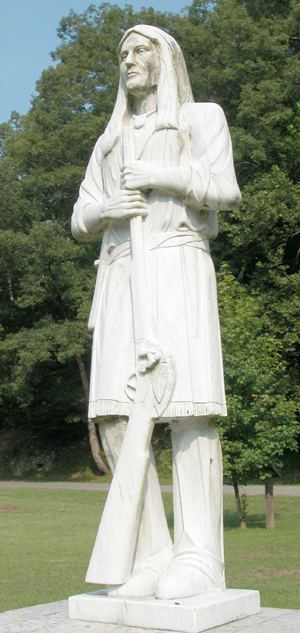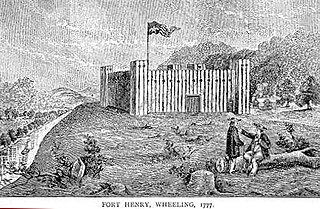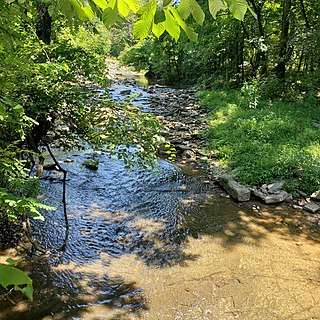
Logan the Orator was a Cayuga orator and war leader born of one of the Six Nations of the Haudenosaunee Confederacy. After his 1760s move to the Ohio Country, he became affiliated with the Mingo, a tribe formed from Seneca, Cayuga, Lenape and other remnant peoples. He took revenge for family members killed by Virginian long knives in 1774 in what is known as the Yellow Creek Massacre. His actions against settlers on the frontier helped spark Dunmore's War later that year.

Lord Dunmore's War, also known as Dunmore's War, was a brief conflict in fall 1774 between the British Colony of Virginia and the Shawnee and Mingo in the trans-Appalachian region of the colony south of the Ohio River. Broadly, the war included events between May and October 1774. The governor of Virginia during the conflict was John Murray, 4th Earl of Dunmore, who in May 1774, asked the House of Burgesses to declare a state of war with the Indians and call out the Virginia militia.

Fort Henry was a colonial fort which stood about ¼ mile from the Ohio River in what is now downtown, Wheeling, West Virginia. The fort was originally known as Fort Fincastle and was named for Viscount Fincastle, Lord Dunmore, Royal Governor of Virginia. Later it was renamed for Patrick Henry, and was at the time located in Virginia. The fort was subject to two major sieges, two notable feats and other skirmishes.
John Gibson was a veteran of the French and Indian War, Lord Dunmore's War, the American Revolutionary War, Tecumseh's War, and the War of 1812. A delegate to the first Pennsylvania constitutional convention in 1790, and a merchant, he earned a reputation as a frontier leader and had good relations with many Native American in the region. At age sixty he was appointed the Secretary of the Indiana Territory where he was responsible for organising the territorial government. He served twice as acting governor of the territory, including a one-year period during the War of 1812 in which he mobilized and led the territorial militia to relieve besieged Fort Harrison.

The Battle of Point Pleasant, also known as the Battle of Kanawha and the Battle of Great Kanawha, was the only major action of Dunmore's War. It was fought on October 10, 1774, between the Virginia militia and Shawnee and Mingo warriors. Along the Ohio River near modern-day Point Pleasant, West Virginia, forces under the Shawnee chief Cornstalk attacked Virginia militiamen under Colonel Andrew Lewis, hoping to halt Lewis's advance into the Ohio Valley. After a long and furious battle, Cornstalk retreated. After the battle, the Virginians, along with a second force led by Lord Dunmore, the Royal Governor of Virginia, marched into the Ohio Valley and compelled Cornstalk to agree to a treaty, which ended the war.

Cornstalk was a Shawnee leader in the Ohio Country in the 1760s and 1770s. His name in the Shawnee language was Hokoleskwa. Little is known about his early life. He may have been born in the Province of Pennsylvania. In 1763, he reportedly led a raid against British American colonists in Pontiac's War. He first appears in historical documents in 1764, when he was one of the hostages surrendered to the British as part of the peace negotiations ending Pontiac's War.
Pickaway Plains is a wide area of rolling hills beginning about 3 miles south of Circleville, Ohio, and extending several miles to the north and south. This geological area was formed by sand and gravel deposited by melting water from the last glacier to retreat from the region during the Ice Age. During the time of inhabitation by the Shawnee, the Pickaway Plains were covered by prairie vegetation, mainly grasses.

William Crawford was an American military officer and surveyor who worked as a land agent alongside George Washington while Washington was a teenager. Crawford fought in the French and Indian War, Lord Dunmore's War and the American Revolutionary War arising to the rank of Colonel. In 1782, his unit was attacked, and while he and his surgeon escaped for less than one day, Crawford was eventually captured where he was tortured and burned at the stake by Crawford's former soldier turned British agent, Simon Girty, and Captain Pipe, a Chief of the Delaware Nation.

The western theater of the American Revolutionary War (1775–1783) was the area of conflict west of the Appalachian Mountains, the region which became the Northwest Territory of the United States as well as what would become the states of Arkansas, Kentucky, Louisiana, Missouri, and Tennessee. The western war was fought between American Indians with their British allies in Detroit, and American settlers south and east of the Ohio River, and also the Spanish as allies of the latter.
Redstone Old Fort — written as Redstone or Red-Stone Fort or Fort Burd — on the Nemacolin Trail, was the name of the French and Indian War-era wooden fort built in 1759 by Pennsylvania militia colonel James Burd to guard the ancient Indian trail's river ford on a mound overlooking the eastern shore of the Monongahela River in what is now Fayette County, Pennsylvania, near, or on the banks of Dunlap's Creek at the confluence. The site is unlikely to be the same as an earlier fort the French document as Hangard dated to 1754 and which was confusedly, likely located on the nearby stream called Redstone Creek. Red sandstones predominate the deposited rock column of the entire region.
Daniel Greathouse (c.1752—1775) was a settler in colonial Virginia. His role in the Yellow Creek massacre in 1774 was instrumental in starting Lord Dunmore's War.

Michael Cresap was a frontiersman born in Maryland, British America.
Colonel Thomas Cresap (c.1702—c.1790) was an English-born settler and trader in the states of Maryland and Pennsylvania. Cresap served Lord Baltimore as an agent in the Maryland–Pennsylvania boundary dispute that became known as Cresap's War. Later, together with the Native American chief Nemacolin, Cresap improved a Native American path to the Ohio Valley, and ultimately settled and became a large landowner near Cumberland, Maryland, where he was involved in further disputes near Brownsville, Pennsylvania, including in the French and Indian War and Lord Dunmore's War.
Snake was the English language name of two Shawnee leaders prominent in the history of the Ohio Country: Peteusha and Shemanetoo. They were both commonly referred to as "Snake" in historical records, or by variations such as "Black Snake" or "Captain Snake," so it is often difficult to determine which individual was being referred to. On a number of occasions, the two Snakes both signed a letter or appeared together, so it is clear they were two different people. There may have been additional Shawnees called "Snake," further complicating the matter. According to historian John Sugden, "it is unlikely if the biographies of these chiefs will ever be completely disentangled."

The Yellow Creek massacre was a killing of several Mingo Indians by Virginian settlers on April 30, 1774. The massacre occurred across from the mouth of the Yellow Creek on the upper Ohio River in the Ohio Country, near the current site of the Mountaineer Casino, Racetrack and Resort. It was the single most important incident contributing to the outbreak of Lord Dunmore's War. It was carried out by a group led by Jacob Greathouse and Daniel Greathouse. Daniel Greathouse died of measles the following year, and Jacob Greathouse was killed in an ambush in 1777. The other perpetrators were never brought to justice.

The Logan Elm that stood near Circleville in Pickaway County, Ohio, was one of the largest American elm trees recorded. The 65-foot-tall (20 m) tree had a trunk circumference of 24 feet (7.3 m) and a crown spread of 180 feet (55 m). Weakened by Dutch elm disease, the tree died from storm damage in 1964. The Logan Elm State Memorial commemorates the site and preserves various associated markers and monuments.

Angus McDonald was a prominent Scottish American military officer, frontiersman, sheriff and landowner in Virginia.
William Ward was the founder of Urbana, Ohio, and one of the original settlers in Kentucky's Mason County and Ohio's Mad River Valley.

David Glenn was of Irish descent and was born about 1753, likely in Pennsylvania but possibly in Virginia. He was one of the early settlers of Kentucky having accompanied James Harrod in founding Harrodstown in 1774, along with his older brother, Thomas. Today, Harrodsburg is considered the oldest permanent white settlement in Kentucky, being it was settled almost a full year before Boonesborough.

Thomas Glenn was among the first pioneers to venture into the Western Virginia and Kentucky territories. He was born in 1750 in Pennsylvania, married before 1770 and settled in present-day Wheeling, West Virginia by 1774, but possibly earlier. He was part of an advanced detachment of John Floyd's survey expedition before joining James Harrod's party in founding Harrodstown, the earliest permanent white settlement west of the Appalachians, along with his younger brother David Glenn. Together they explored a large portion of Kentucky in the 1770s, making several improvements from Frankfort down to Russell Springs.













